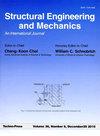Computation of design forces and deflection in skew-curved box-girder bridges
IF 3
4区 工程技术
Q2 ENGINEERING, CIVIL
引用次数: 1
Abstract
The analysis of simply supported single-cell skew-curved reinforced concrete (RC) box-girder bridges is carried out using a finite element based CsiBridge software. The behaviour of skew-curved box-girder bridges can not be anticipated simply by superimposing the individual effects of skewness and curvature, so it becomes important to examine the behaviour of such bridges considering the combined effects of skewness and curvature. A comprehensive parametric study is performed wherein the combined influence of the skew and curve angles is considered to determine the maximum bending moment, maximum shear force, maximum torsional moment and maximum vertical deflection of the bridge girders. The skew angle is varied from 0o to 60o at an interval of 10o, and the curve angle is varied from 0o to 60o at an interval of 12o. The scantly available literature on such bridges focuses mainly on the analysis of skew-curved bridges under dead and point loads. But, the effects of actual loadings may be different, thus, it is considered in the present study. It is found that the performance of these bridges having more curvature can be improved by introducing the skewness. Finally, several equations are deduced in the non-dimensional form for estimating the forces and deflection in the girders of simply supported skew-curved RC box-girder bridges, based upon the results of the straight one. The developed equations may be helpful to the designers in proportioning, analysing, and designing such bridges, as the correlation coefficient is about 0.99.斜弯箱梁桥设计力及挠度计算
采用基于有限元的CsiBridge软件对钢筋混凝土斜弯简支箱梁桥进行了分析。斜曲箱梁桥的性能不能简单地通过叠加斜度和曲率的单独影响来预测,因此考虑斜度和曲率的综合影响来检查此类桥梁的性能变得重要。考虑了斜角和曲线角的综合影响,进行了全面的参数化研究,确定了桥梁梁的最大弯矩、最大剪力、最大扭转矩和最大竖向挠度。斜角以100度为间隔从00度变化到600度,曲线角以120度为间隔从00度变化到600度。目前有关此类桥梁的文献很少,主要集中在恒荷载和点荷载作用下的斜曲桥的分析。但是,实际荷载的影响可能是不同的,因此,在本研究中考虑了这一点。研究发现,引入偏度可以改善具有较大曲率的桥梁的性能。最后,在斜弯简支梁桥的计算结果的基础上,导出了斜弯简支梁的受力和挠度的无量纲计算公式。该方程的相关系数约为0.99,可为此类桥梁的配合比、分析和设计提供参考。
本文章由计算机程序翻译,如有差异,请以英文原文为准。
求助全文
约1分钟内获得全文
求助全文
来源期刊

Structural Engineering and Mechanics
工程技术-工程:机械
CiteScore
3.80
自引率
18.20%
发文量
0
审稿时长
11 months
期刊介绍:
The STRUCTURAL ENGINEERING AND MECHANICS, An International Journal, aims at: providing a major publication channel for structural engineering, wider distribution at more affordable subscription rates; faster reviewing and publication for manuscripts submitted; and a broad scope for wider participation.
The main subject of the Journal is structural engineering concerned with aspects of mechanics. Areas covered by the Journal include:
- Structural Mechanics
- Design of Civil, Building and Mechanical Structures
- Structural Optimization and Controls
- Structural Safety and Reliability
- New Structural Materials and Applications
- Effects of Wind, Earthquake and Wave Loadings on Structures
- Fluid-Structure and Soil-Structure Interactions
- AI Application and Expert Systems in Structural Engineering. Submission of papers from practicing engineers is particularly encouraged.
 求助内容:
求助内容: 应助结果提醒方式:
应助结果提醒方式:


